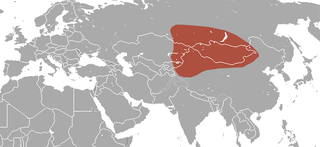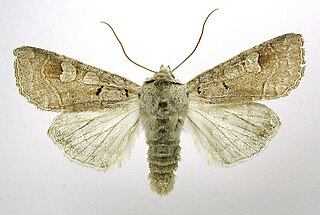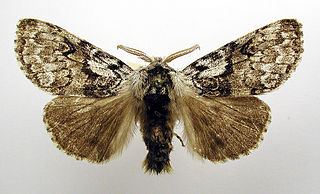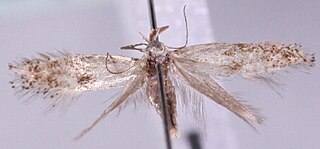
Firs are evergreen coniferous trees belonging to the genus Abies in the family Pinaceae. There are approximately 48–65 extant species, found on mountains throughout much of North and Central America, Europe, Asia, and North Africa. The genus is most closely related to Cedrus (cedar). The genus name is derived from the Latin "to rise" in reference to the height of its species. The common English name originates with the Old Norse, fyri, or the Old Danish, fyr.

Pinus sibirica, or Siberian pine, in the family Pinaceae is a species of pine tree that occurs in Siberia from 58°E in the Ural Mountains east to 126°E in the Stanovoy Range in southern Sakha Republic, and from Igarka at 68°N in the lower Yenisei valley, south to 45°N in central Mongolia.

Larix sibirica, the Siberian larch or Russian larch, is a frost-hardy tree native to western Russia, from close to the Finnish border east to the Yenisei valley in central Siberia, where it hybridises with the Dahurian larch L. gmelinii of eastern Siberia; the hybrid is known as Larix × czekanowskii.

Iris sibirica, commonly known as Siberian iris or Siberian flag, is a species of flowering plant in the family Iridaceae. It is a rhizomatous herbaceous perennial, from Europe and Central Asia. It has long green grass-like leaves, tall stem, 2–5 violet-blue, to blue, and occasionally white flowers. It is cultivated as an ornamental plant in temperate regions.

The Siberian shrew is a species of mammal in the family Soricidae. It is found in Russia, and possibly China and Mongolia.

The Levant mole is a species of mammal in the family Talpidae. It is found in Armenia, Azerbaijan, Georgia, Russia, and Turkey.

Sphinx morio, the larch hawk moth or Asian pine hawkmoth, is a moth of the family Sphingidae. It is found in Russia, the Korean Peninsula, Japan and China.

Ammoconia is a genus of moths of the family Noctuidae.

Macaria signaria, the dusky peacock, pale-marked angle or spruce-fir looper, is a moth of the family Geometridae. The species was first described by Jacob Hübner in 1809. Subspecies Semiothisa signaria signaria is found in Europe, Turkey, the Caucasus, Transcaucasia, the Ural, Siberia, Far East, Sakhalin, northern Iran and Japan. Subspecies Macaria signaria dispuncta is found in North America.

Agrochola helvola, the flounced chestnut, is a moth of the family Noctuidae. It was first described by Carl Linnaeus in his landmark 1758 10th edition of Systema Naturae. The species is found in most of Europe, north to Scotland and Fennoscandia up to the Arctic Circle, south to Spain, Sicily, Greece further east to the Middle East, Armenia, Asia Minor, western Turkestan and central Asia up to central Siberia.

Rhodostrophia calabra is a moth of the family Geometridae first described by Vincenzo Petagna in 1786. It is found from the Iberian Peninsula and a small isolated population in Morocco, through southern France, the western and southern Alps, Italy, the eastern coast of the Adriatic Sea to the southern parts of the Balkan Peninsula. In central Europe it is only found as an isolated population in central France and Rheinland-Pfalz. It is not found on the islands in the Mediterranean Sea. In the Balkans there is an isolated population in the border region of northern Bulgaria and Serbia. Furthermore, it is present on the eastern shores of the Black Sea in Turkey and in the Caucasus.

Chrysoesthia sexguttella, common name the orache leafminer moth, is a moth in the family Gelechiidae. It is found in all of Europe, east to southern Siberia, as well as the north-eastern parts of North America, where it might be an introduced species.

Calliteara abietis is a moth of the family Erebidae. It is found from northern and central Europe, through Russia to Japan.

Euxoa sibirica, the Siberian cutworm, is a moth of the family Noctuidae. It is found from western Siberia to the Amur region. It is also found on the Kuriles and in Sakhalin, Mongolia, western China, Tibet, Afghanistan, Nepal, India, the Korean Peninsula and Japan.

Ammoconia senex is a moth of the family Noctuidae. It is found in the European part of the Mediterranean Region and an isolated population near the Middle Rhine. It is also found in Turkey, the Caucasus, Iraq and Iran.
Coleophora sibirica is a moth of the family Coleophoridae. It is found in Russia.

Perittia sibirica is a moth of the family Elachistidae. It is found in Russia.

Ammoconia aholai is a moth of the family Noctuidae. It is endemic to Cyprus.
Chelis reticulata is a moth in the family Erebidae. It was described by Hugo Theodor Christoph in 1887. It is found in the Caucasus, Transcaucasia, Armenia, the Kopet Dagh, Asia Minor, Syria, northern Lebanon and northern Iran.
Eogystia sibirica is a moth in the family Cossidae. It is found in north-eastern Russia, Mongolia and northern China.

















